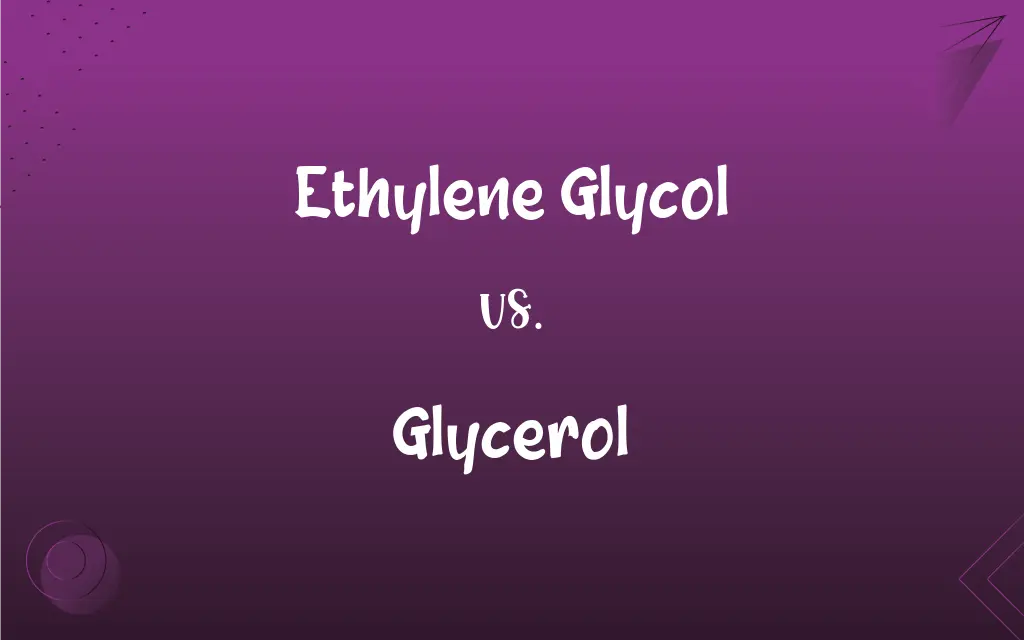Ethylene Glycol vs. Glycerol: What's the Difference?
Edited by Aimie Carlson || By Janet White || Published on December 16, 2023
Ethylene glycol is a toxic organic compound used in antifreeze, while glycerol is a non-toxic compound used in food, pharmaceuticals, and cosmetics.

Key Differences
Ethylene glycol, a diol, is primarily used in antifreeze and coolant formulations due to its low freezing point. Glycerol, a triol, is known for its hygroscopic nature and is widely used in food, pharmaceuticals, and cosmetic products for moisture retention.
The toxicity of ethylene glycol makes it hazardous for human consumption, often requiring careful handling. In contrast, glycerol is non-toxic and safe for use in various consumer products, including food items and skin-care products.
Ethylene glycol is utilized in industrial applications, such as in the production of polyester fibers and resins. Glycerol finds use in medical and personal care products due to its skin-friendly properties and as a sweetener in food products.
In terms of physical properties, ethylene glycol is a colorless, odorless liquid with a sweet taste, which contributes to its hazardous nature if ingested. Glycerol, also colorless and odorless, is recognized for its viscosity and sweet taste, making it suitable for culinary uses.
Environmental impact is another consideration, as ethylene glycol can be harmful to the environment if not disposed of properly. Glycerol, being biodegradable and non-toxic, poses less environmental risk.
ADVERTISEMENT
Comparison Chart
Primary Use
Antifreeze, Coolants
Food, Pharmaceuticals, Cosmetics
Toxicity
Toxic, hazardous for consumption
Non-toxic, safe for consumption
Industrial Applications
Polyester production, Industrial solvents
Medical, Personal care, Food industry
Physical Properties
Colorless, Odorless, Sweet tasting
Colorless, Odorless, Viscous, Sweet tasting
Environmental Impact
Potentially harmful if not disposed properly
Biodegradable, minimal environmental risk
ADVERTISEMENT
Ethylene Glycol and Glycerol Definitions
Ethylene Glycol
A chemical with a low freezing point, making it suitable for deicing applications.
Ethylene glycol is used at airports for deicing planes.
Glycerol
A component in pharmaceuticals, often used in cough syrups and elixirs.
Glycerol is used in cough syrups for its soothing effect.
Ethylene Glycol
A diol used in the production of polyester fibers and resins.
Polyester fabrics are often made using ethylene glycol.
Glycerol
A non-toxic triol used as a moisturizer in cosmetics and skin care products.
Glycerol is a common ingredient in lotions for its hydrating properties.
Ethylene Glycol
A sweet-tasting, colorless liquid used in industrial solvents.
Ethylene glycol is also found in some hydraulic brake fluids.
Glycerol
A food additive used for its sweetness and moisture-retaining qualities.
Glycerol is added to baked goods to keep them moist.
Ethylene Glycol
A toxic organic compound used in antifreeze and coolant solutions.
Ethylene glycol is the main ingredient in most car antifreeze products.
Glycerol
A biodegradable substance used in eco-friendly products.
Eco-friendly soaps often contain glycerol.
Ethylene Glycol
A hazardous substance requiring careful handling and disposal.
Ethylene glycol spills need to be managed with caution due to its toxicity.
Glycerol
A versatile compound used in the food, cosmetic, and pharmaceutical industries.
Glycerol's versatility makes it a popular choice in multiple industries.
Glycerol
A syrupy, sweet, colorless or yellowish liquid triol, C3H8O3, obtained from fats and oils as a byproduct of saponification and used as a solvent, antifreeze, plasticizer, and sweetener and in the manufacture of dynamite, cosmetics, liquid soaps, inks, and lubricants.
Glycerol
(organic compound) 1,2,3-trihydroxy-propane or propan-1,2,3-triol; a trihydric alcohol
Glycerol
A syrupy sweet liquid obtained as a by-product in the manufacture of soap from animal or vegetable oils and fats; it is used as an antifreeze, a plasticizer, and a food sweetener and in the manufacture of dynamite, cosmetics etc.
Glycerol
Same as Glycerin.
Glycerol
A sweet syrupy trihydroxy alcohol obtained by saponification of fats and oils
FAQs
Is ethylene glycol harmful to the environment?
Ethylene glycol can be environmentally harmful if not disposed of properly.
What are the uses of glycerol?
Glycerol is used in food products, cosmetics, and pharmaceuticals.
Is ethylene glycol toxic to humans?
Yes, ethylene glycol is toxic and can be harmful if ingested.
What is ethylene glycol used for?
Ethylene glycol is used in antifreeze, coolants, and industrial solvents.
What are the physical properties of ethylene glycol?
Ethylene glycol is colorless, odorless, and has a sweet taste.
Can glycerol be ingested safely?
Yes, glycerol is non-toxic and safe for consumption.
Is glycerol biodegradable?
Yes, glycerol is biodegradable and environmentally friendly.
What is glycerol commonly found in?
Glycerol is commonly found in lotions, baked goods, and cough syrups.
Is ethylene glycol used in polyester production?
Yes, ethylene glycol is used in making polyester fibers and resins.
What makes glycerol suitable for pharmaceutical use?
Glycerol's non-toxic nature and soothing properties make it suitable for pharmaceuticals.
Can glycerol be used in hair care products?
Yes, glycerol is often used in hair care products for hydration.
Can ethylene glycol be used in food?
No, ethylene glycol is toxic and should not be used in food.
Why is glycerol used in food products?
Glycerol is used in food for its moisture-retaining and sweetening properties.
How does glycerol benefit skin care?
Glycerol helps in skin care by hydrating and protecting the skin.
Are there any environmental concerns with glycerol?
Glycerol is environmentally friendly and poses minimal risk.
Can ethylene glycol freeze?
Ethylene glycol has a low freezing point, which is why it's used in antifreeze.
Is ethylene glycol found in household products?
Ethylene glycol can be found in some household cleaners and brake fluids.
How is glycerol used in cosmetics?
Glycerol is used in cosmetics as a moisturizer and to improve texture.
What precautions are needed when handling ethylene glycol?
Handling ethylene glycol requires care to avoid ingestion and skin contact.
What industries rely heavily on ethylene glycol?
The automotive and textile industries rely heavily on ethylene glycol.
About Author
Written by
Janet WhiteJanet White has been an esteemed writer and blogger for Difference Wiki. Holding a Master's degree in Science and Medical Journalism from the prestigious Boston University, she has consistently demonstrated her expertise and passion for her field. When she's not immersed in her work, Janet relishes her time exercising, delving into a good book, and cherishing moments with friends and family.
Edited by
Aimie CarlsonAimie Carlson, holding a master's degree in English literature, is a fervent English language enthusiast. She lends her writing talents to Difference Wiki, a prominent website that specializes in comparisons, offering readers insightful analyses that both captivate and inform.






































































